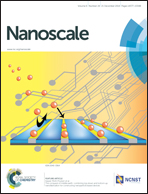Self-assembled proteinticle nanostructures for 3-dimensional display of antibodies†
Abstract
“Proteinticle” is a nano-scale protein particle that is self-assembled inside cells with constant 3D structure and surface topology. The binding of IgG to the B domain of Staphylococcal protein A (SPAB) molecules that are genetically inserted on the surface of proteinticle enables the variable domains of bound IgG to be well oriented to effectively capture antigens, accordingly forming a highly sensitive 3D IgG probe. The five different proteinticles that originate from humans, bacteria, and virus and totally differ in size, shape, and surface structure were used for the surface display of SPAB. The dissociation constant (KD) in the binding of IgG to SPAB on the proteinticle surface was estimated based on the Langmuir adsorption isotherm model: KD was 1–3 orders-of-magnitude lower compared to the previously reported KD in the binding of IgG to Staphylococcal protein A. The surface density and distribution of SPAB and especially the existence of hot (or highly congested) spots of SPAB, which depend on the surface structure and the number of subunits as well as size and shape of proteinticle, is of crucial importance for the effective binding of IgG to SPAB on proteinticles. Although the five different proteinticles were demonstrated as proof-of-concept here, SPAB-mediated immobilization of IgG on the other proteinticles would be very useful for the fabrication of sensitive 3D immunoassay platforms.


 Please wait while we load your content...
Please wait while we load your content...